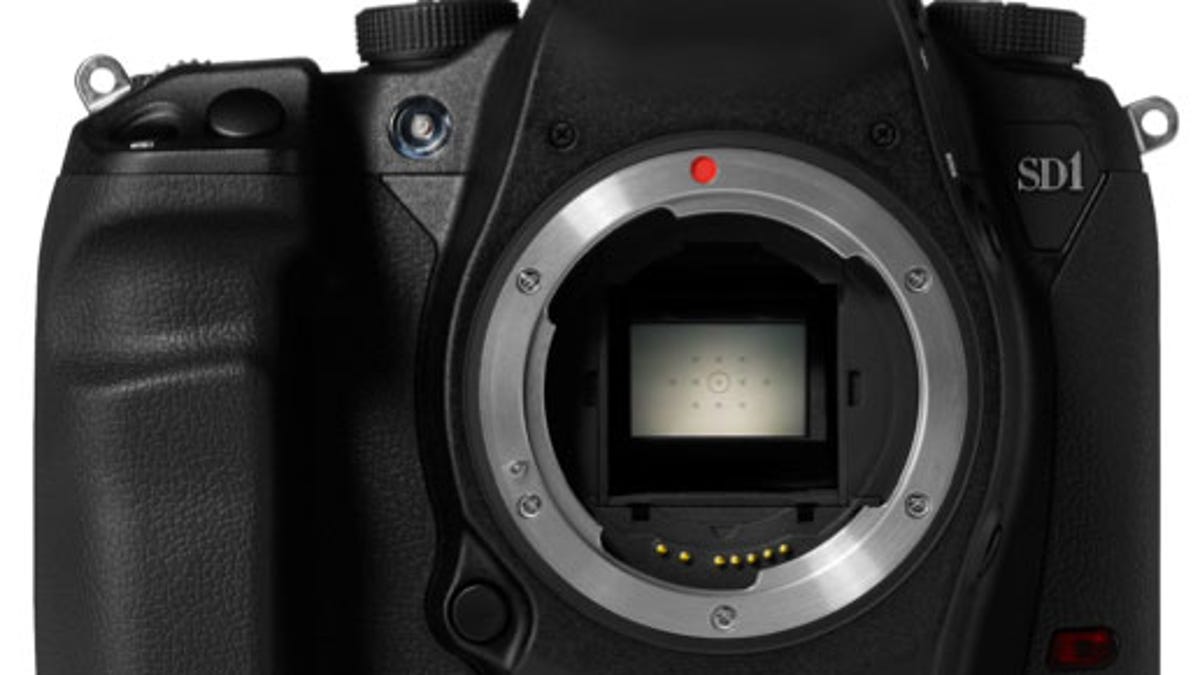Sigma starts afresh with novel SLR design
The Japanese camera equipment maker expects the new Foveon sensor in its upcoming SD1 will prove more competitive. Also: New image-stabilized lenses and Sigma's financial crisis.

COLOGNE, Germany--Sigma, the Japanese company best known for its lenses, announced an overhauled effort yesterday to expand to camera making as well with an SLR called the SD1 due to ship in February.
Like Sigma's current SLR, the SD15, the SD1 has at its heart a Foveon image sensor, an unusual design that departs significantly from prevailing industry practice with a design that captures red, green, and blue at each pixel site rather than just one of the three colors.
The Foveon sensor made Sigma's SD line stand out from the crowd--but often not in a good way. Some critics didn't like its images, Foveon delays set back Sigma products such as its SLRs and its DP1 compact camera that used it, and the cameras didn't live up to their revolutionary promise. In 2008, Sigma acquired Foveon.
Now Sigma is trying again with a larger, much higher-resolution sensor. It's awkward to compare megapixel ratings with Foveon and conventional Bayer-pattern sensors, because the latter must interpolate the missing red, green, and blue data for each pixel through a process called demosaicing, while the Foveon chips capture all that data. But what's clear is the new SD1 will be much more competitive.
Specifically, where the SD14 had a 4.6-megapixel sensor, the SD1 will have a 15.3-megapixel sensor, a "giant technological leap," said Chief Operating Officer Kazuto Yamaki at a press meeting at the Photokina show here.
He promised the 4,800x3,200-pixel sensor would have the superior color resolution and color sharpness and that its black-and-white resolution--a sore point for earlier Foveon designs--would be vastly improved, rising to the equivalent of a 30-megapixel sensor with a conventional Bayer pattern color filter array.
"It indicates a new beginning for Sigma cameras and Foveon sensors," Yamaki said.
And Sigma is trying to step up with a tough magnesium alloy chassis and a dustproof and splashproof design, he said.
"The SD1 is designed to be a really professional camera," he said. "This is our flagship camera."
The new sensor also is physically larger, which makes it more expensive but increases its light-gathering abilities. The SD15 had a crop factor of 1.7 compared to a full-frame 35mm film camera, compared to 1.6 for Canon's mainstream SLRs. Sigma's SD1 sensor will match Nikon with a crop factor of 1.5 with a 24x16mm size, said Mark Amir-Hamzeh, general manager of Sigma Corporation of America, the company's U.S. group.
The camera also comes with a new autofocus system with 11 cross points. However, it won't shoot video or permit live view through the camera display, something all new SLRs from larger rivals now can. It will employ the True II image-processing chip.
Sigma didn't announce prices, but Amir-Hamzeh said it would be "very competitive" and in the neighborhood of Canon's higher-end EOS 7D, which costs about $1,500 with no lens and $1,700 with a 28-135mm kit lens.
A few more tidbits: The SD1 will use CompactFlash memory cards, common in higher-end SLRs. It has a 3-inch, 460,000-pixel LCD. Its viewfinder will have 98 percent coverage with magnification of 0.95x magnification. It's got a built-in flash. And its dimensions are 5.7 inches wide by 4.4 inches tall by 3.1 inches deep.
New Sigma lenses
Sigma also announced two new higher-end lenses at Photokina: the APO 120-300mm F2.8 EX DG OS HSM and the APO Macro 150mm F2.8 EX DG OS HSM. Both are geared for use on full-frame cameras and are dustproof and splashproof, and both are due to ship in January or February, Amir-Hamzeh said.
Each replaces a similar predecessor but adds Sigma's optical stabilization technology to help counteract camera shake. That's particularly important in telephoto lenses; Sigma promises four stops' worth of improvement, meaning that a stationary subject could be shot handheld at 1/25 of a second with the same steadiness as would otherwise be achievable with 1/400 of a second. Image stabilization is difficult to quantify, but its benefits are clear.
Yamaki trumpeted the new 120-300mm model, which he perhaps ambitiously hoped pro photographers would use to replace the $10,000 combination of Canon's high-end 70-200mm F2.8 and 300mm F2.8 lenses.
"Probably this is the best telephoto lens Sigma has ever produced," he declared. In addition to the OS, the lens also gets two elements made of Sigma's new high-end FLD glass, which the company says matches the fluorite elements Canon uses in bending light rays without as much chromatic aberration. FLD stands for F low dispersion.
The lenses embody Sigma's response to a financial crisis: the changing value of the yen compared to the euro, pound, and U.S. dollar means that Sigma in recent years effectively saw much of its non-Japanese revenue cut by between 20 percent and 25 percent, Yamaki said.
Rather than lay off staff or move factories out of Japan to cheaper areas, though, Sigma decided to try to grow faster by releasing more and higher-quality lenses. The FLD glass is one example of the company's improvements.
"We tried to stimulate the market and create customer demand," Yamaki said. "We tried to change ourselves, and I think we did that." The company's goal is to be "the finest optics company in the world."
Sigma faces plenty of challenges--not just entrenched incumbents but also a changing camera market that's sprouting new lens mounts like flowers with the arrival of compact interchangeable lens cameras (ILCs) such as Samsung's NX line, Sony's NEX line, and the Micro Four Thirds models from Panasonic and Olympus.
But Sigma founder and Chief Executive Michihiro Yamaki, in an interview at the press event, said Sigma has the advantage of agility over large rivals when it comes to responding to new developments. And the company's strategy is working, he said: lens shipments increased dramatically in the last year.

